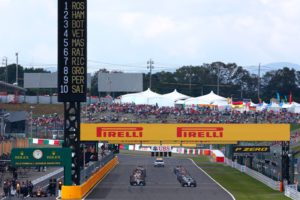The Japanese Grand prix will be the 17th round from the 2016 FIA Formula One Championship. The race will be held traditionally at the Suzuka circuit.

Winner in 2015 Lewis Hamilton, 53 laps, 1:28:06.508s
2015 pole position Nico Rosberg, 1m32.584s
Fastest lap in 2015 Lewis Hamilton, 1m36.145s (lap 33)
Name Suzuka International Racing Course
First race 1987
Circuit length 5.807km/3.608 miles and it is 5th longest of the season
Distance to Turn One 350m/0.217 miles (longest of season: Barcelona 730m/0.454 miles)
Longest straight 900m/0.559 miles, on the approach to the Chicane
Top speed 330km/h/205mph, on the approach to the Chicane
Pitlane length 413m/0.257 miles, estimated time loss 23s (longest of season: Silverstone, 489m/0.304 miles)
Full throttle 65 per cent, with the longest period of full throttle being 16s
DRS zones One, on the approach to Turn One
Key corner Turn Nine – it is a third-gear right-hander that passes underneath 130R at the exit to create the unique figure-of-eight shape of Suzuka. Also known as ‘Degner Two’, this corner is relatively slow, but a bump on entry makes it difficult to get the car into the apex. There’s very little run-off due to the bridge, so the smallest of mistakes can prove very costly
Fastest corner 300km/h (186mph), Turn 15
Slowest corner 72km/h (45mph), Turn 11
Major changes for 2016 None, except for maintenance work on kerbs and Astroturf
Fuel consumption 1.89kg per lap, which is average
ERS demands Medium. An interesting mix of slow, medium and fast corners tests every aspect of car performance, including the ERS
Brake wear Low. Only 10 per cent of the lap is spent braking, with only one significant braking event, into the Chicane
Gear changes 42 per lap/2,226 per race

Power unit notes
- Suzuka is one of the toughest circuits of the year for the ICE. The sustained bursts of throttle test the internals’ strength, while the heavy braking events challenge reactivity and reliability. Over 60% of the lap is at full throttle – the majority of this comes in the second half of the track from the exit of the Spoon corner (Turn 14) to the chicane on the entry of the pit straight. This includes a pass through the 130R, which is taken at over 300kph despite being a flowing left hand bend!
- With a top speed peaking at almost 340kph, Suzuka gives rise to one of the highest speed seen in the second part of the year. Inside the ICE the pistons turn at an incredible 200 times per second, generating enormous internal forces.
- The second slowest corner is the chicane – the speed there is approximately 80kph. This is the best chance to recover energy through the MGU-K as the cars approach at well over 330kph. Drivers brake down to under 100kph and that generates huge amounts of heat and energy in the brakes.

































